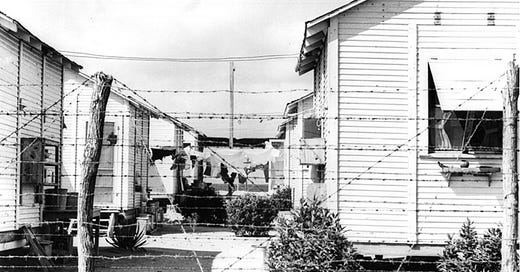Today is Liberation Day. For our new subscribers (welcome, all!), we are reposting this podcast we published last year, on Bonaire’s role in WWII. Enjoy.
FULL PODCAST TEXT BELOW
Tomorrow is the 4th of May, the day when the Kingdom of the Netherlands mourns and commemorates all victims of war, military and civilian, that have perished since the outbreak of the Second World War until the present day.
To mark the occasion, The Terramar Museum in cooperation with the National Committee 4 & 5 May and the Culture Department of the Public Entity Bonaire will host a small exhibition that opens tomorrow, May 4th.
Today’s subscriber-only podcast is called ‘When War Came To Bonaire’, a 5-minute short story on some of the ways in which World War II became a painful reality to the island and its people.
FULL PODCAST TEXT BELOW
CREDITS - When War Came To Bonaire
Story author and narrator: Arjen de Wolff
Sound engineer: Michiel van Bokhorst
Music composer: Wim Statius Muller, Antillean Dances Op. 2, no. 3, ‘Tristesa’.
When War Came To Bonaire
On the 16th of February, 1942, Aruba, Curaçao and Bonaire were introduced to the Second World War as an armed conflict.
On that day, a coordinated attack by German submarines hit various oil tankers anchored in Aruba.
Right outside the Anna Bay in Curaçao, U-boat 67 torpedoed the steam tanker ‘Rafaela’.
The ABC islands, specifically the oil refinery plants in Aruba and Curaçao, played a pivotal role in the Allied war effort.
With the European part of The Netherlands now firmly under German control, protection of the free and unoccupied Dutch Caribbean islands fell mostly to British and US troops.
Bonaire, the island closest to the open Atlantic, was home to one of the first radar stations in the Caribbean.
The listening post, situated at the site called ‘Tanki Maraka’ was manned by US servicemen and provided an early warning system, to defend the refineries and ensure the continued provision of vital fuel to the Allied military effort.
As such, Bonaire, Aruba and Curaçao were important targets for Nazi Germany and as the events of February 1942 had proven, the islands were well within reach of the mighty German submarine fleet.
Unlike Aruba and Curaçao, Bonaire itself did not possess any oil infrastructure.
The island did however serve as the principal location of internment for hundreds of inhabitants of Aruba, Curaçao and Bonaire, that were deemed “a threat to the security and stability of this part of the Realm”, as the Royal Decree put it.
These ‘undesirables’ were to be brought together and encamped in a guarded facility on Bonaire.
On the evening of May 10, 1940, when the German army had invaded the European part of the Netherlands, ships carrying over 400 people reached the harbor of Bonaire.
However, the camp that was to house the internees was not ready yet.
So, before being moved to the permanent camp, internees were split up into three main groups: Dutch members of the NSB - or National Socialist Movement - the political party in The Netherlands that sympathized with Adolf Hitler and the Nazi party - were sent to the Public School on Wilhelminaplein.
German males were housed in the Dominicus School, and women and children were lodged in the Bernardus School.
Eventually, present day Divi Flamingo Hotel (the former Hotel Zeebad) became the central internment location, with Camp Guatemala serving as an auxiliary facility, until the end of the war in 1945.
Unfortunately, the authorities were not always diligent when separating friend from foe.
And so it happened that in Bonaire, German Jews, and others that opposed the Nazi’s ended up being imprisoned together with the very people that wanted them persecuted and exterminated.
Officially, 129 men and women from the Dutch Antilles lost their lives as a result of the violence of World War II.
The names of some of them are still taught in history class today. George Maduro, son of a Sephardic Jewish family from Curaçao, was a cavalry officer in the Dutch army.
He died in the Dachau concentration camp.
Boy Ecury, from Aruba, was a well known member of the Dutch resistance.
Boy and his fellow Antillean resistance fighters Luis de Lannoy, Delfincio Navarro and Tirso Sprockel, were able to conduct their activities and elude the German occupiers for some time by communicating in Papiamentu.
At last though, Ecury was caught, and the Germans executed him near The Hague.
These are the men we know. But many more are remembered and mourned only by their families.
More than thirty Bonairians lost their lives in the hostilities of the Second World War.
Many of them were lost at sea, working on the merchant ships that played a vital role in ferrying desperately needed fuel, food and other provisions to fight the German war machine.
On the 27th of May, 1942, off the coast of Barbados, German submarine captain Adolf Piening spotted an unescorted steam merchant under Dutch flag.
After an initial salvo missed its target, a second spread of torpedoes fired from U-boat 155 hit the ship between the stack and mast aft.
Early the following morning, shortly after 6:30, the merchant vessel sank.
Of the 32 crew, none survived.
That merchant ship is believed to have been the “Poseidon”, owned by Dutch shipping company KNSM. One of the Poseidon’s sailors: Johan Marco Josefa, born on October 7, 1896, on Bonaire.
In the harbor of Kralendijk, a war monument can be seen. Inscribed on it are the “official” Antillean victims of World War II.
But the name of Johan Marco Josefa, the Bonairian sailor of the Poseidon who died in the dark depths of the Atlantic Ocean, is not among them.












Share this post